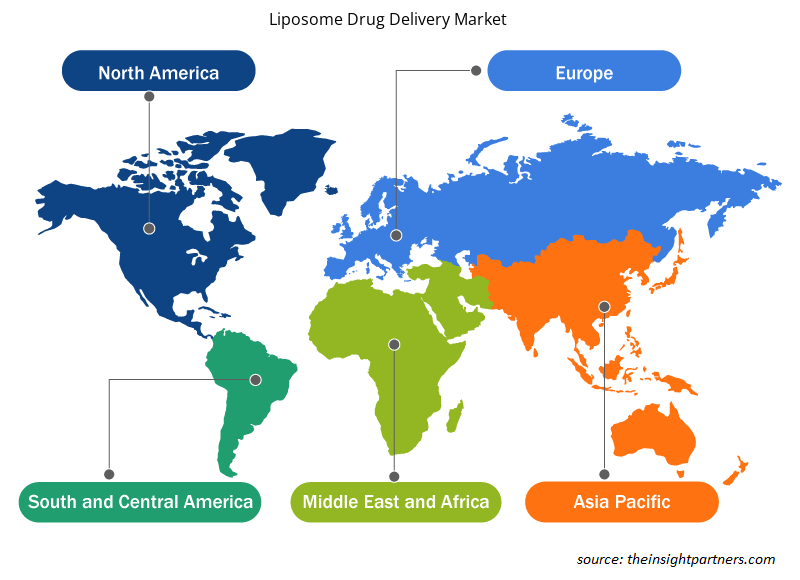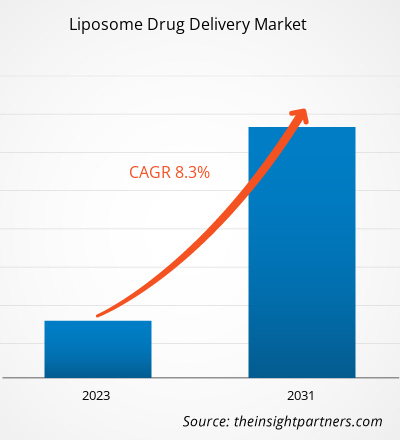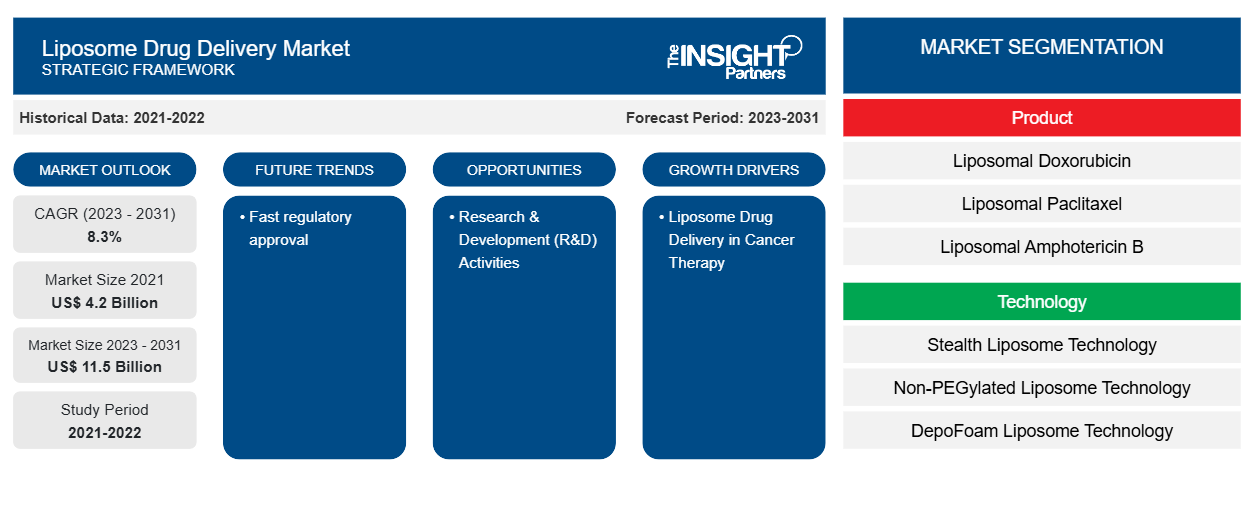Der Markt für Arzneimittelverabreichung mit Liposomen wurde 2021 auf 4,2 Milliarden US-Dollar geschätzt und soll bis 2031 11,5 Milliarden US-Dollar erreichen. Von 2023 bis 2031 wird für den Markt eine durchschnittliche jährliche Wachstumsrate von 8,3 % erwartet. Eine schnelle behördliche Zulassung dürfte weiterhin ein wichtiger Trend auf dem Markt für Arzneimittelverabreichung mit Liposomen bleiben.
Liposome Drug DeliveryMarktanalyse
Arzneimittelverabreichung mit Liposomen in der Krebstherapie
Liposomen haben die Krebstherapie aufgrund ihrer breiten Anwendungsmöglichkeiten revolutioniert. Beispielsweise waren Liposomen aufgrund ihrer Biokompatibilität und biologischen Abbaubarkeit das erste nanotechnologiebasierte Arzneimittelverabreichungssystem, das für klinische Anwendungen zugelassen wurde. Darüber hinaus haben sich Liposomen in nanoträgerbasierten Arzneimittelverabreichungssystemen für erfolgreiche klinische Anwendungen liposomaler Formulierungen zur Krebstherapie etabliert . Darüber hinaus verfügen liposomale Arzneimittel über hohe Verkapselungseigenschaften und zeigen eine signifikante Antikrebsaktivität durch Verringerung der Toxizität und insbesondere der Kardiotoxizität. Eine solche Verkapselungstechnik für die liposomale Behandlung (Verkapselung) zeigt eine große verlängerte Zirkulation, ähnlich wie „Daunorubicin“ und „Pegyliertes liposomales Doxorubicin“. Die oben genannten Faktoren sind für das einflussreiche Wachstum des Marktes für liposomale Arzneimittelverabreichung in den Jahren 2021–2031 verantwortlich.
Marktübersicht zur Verabreichung von Arzneimitteln auf Liposomenbasis
Technologie, Innovation und intelligente technologische Lösungen wie diese beeinflussen die Verabreichung von Medikamenten über Liposomen weiterhin erheblich. Die Verabreichung von Medikamenten über Liposomen in der Krebstherapie und effiziente Produkteinführungen für die Verabreichung von Medikamenten über Liposomen sind die einflussreichsten Faktoren für das Wachstum des Marktes für die Verabreichung von Medikamenten über Liposomen. Eine schnelle behördliche Zulassung ist ein wichtiger Trend für das Wachstum des Marktes für die Verabreichung von Medikamenten über Liposomen. Forschungs- und Entwicklungsaktivitäten (F&E) bieten lukrative Marktchancen.
Passen Sie diesen Bericht Ihren Anforderungen an
Sie erhalten kostenlos individuelle Anpassungen an jedem Bericht, einschließlich Teilen dieses Berichts oder einer Analyse auf Länderebene, eines Excel-Datenpakets sowie tolle Angebote und Rabatte für Start-ups und Universitäten.
- Holen Sie sich die wichtigsten Markttrends aus diesem Bericht.Dieses KOSTENLOSE Beispiel umfasst eine Datenanalyse von Markttrends bis hin zu Schätzungen und Prognosen.
Liposome Drug DeliveryMarkttreiber und Chancen
Effiziente Produkteinführungen für die Verabreichung von Arzneimitteln über Liposomen begünstigen den Markt
- Im Oktober 2021 kündigte Evonik die Einführung des „LIPEX EXTRUDER“ der nächsten Generation für die schnelle und effektive Herstellung liposomaler Arzneimittel an. LIPEX bietet einen hohen Durchsatz und schnellere Chargenproduktionszeiten für Formulierungen zur Verabreichung liposomaler Arzneimittel.
- Im Januar 2022 gaben Pfizer und Acuitas Therapeutics eine strategische Zusammenarbeit für die potenzielle Nutzung von Acuitas „Lipid Nanoparticle (LNP) Technology“ bekannt. Die Technologie ist sowohl für die Impfstoff- als auch für die Therapeutikaentwicklung vielversprechend. Sie unterstreicht Pfizers Engagement für innovative Lösungen und ebnet den Weg für neue Fortschritte auf diesem Gebiet.Acuitas Therapeutics announced a strategic collaboration for Acuita's "Lipid Nanoparticle (LNP) Technology" for potential utilization. The technology holds promise for both vaccine and therapeutic development, focussing on Pfizer's commitment to innovative solutions and paying the way for novel advancements in the field.
Daher werden effiziente Produkteinführungen und strategische Kooperationen im Bereich der Verabreichung von Liposomen als Arzneimittel in den kommenden Jahren einen wesentlichen Beitrag leisten.
Forschungs- und Entwicklungsaktivitäten (F&E) für den Markt für liposomale Arzneimittelverabreichung – eine Chance
Die führenden Hersteller, die Arzneimittelverabreichung über Liposomen entwickeln, konzentrieren sich auf F&E-Aktivitäten zur Entwicklung von Nanomaterialien, Nanosphären, Liposomen und Nanopartikeln. Eine solche Arzneimittelverabreichung über Liposomen kann Arzneimittelaktivitäten in vivo und in vitro für die klinische Routinepraxis nutzen. Seit der Entdeckung der Liposomen der ersten Generation haben sich Lipidnanopartikel (LNPs) enorm weiterentwickelt und werden in der Pharmaindustrie häufig eingesetzt. Ein weiterer Ansatz, der derzeit untersucht wird, sind beispielsweise stimuliresponsive Liposomen, die die Arzneimittelverabreichung in Tumoren verbessern, wobei sie so konzipiert sind, dass sie unter bestimmten physikochemischen oder biochemischen Reizen freigesetzt werden. Beispiele hierfür sind „Doxorubicin“, „5-Fluorouracil“ und „AMD3100“. Darüber hinaus umfasst die zukünftige Forschung eine Reihe von klinischen Studien der Phase 1/2, in denen derzeit die LNP-Formulierung als Ziel der Krebsimmuntherapie für solide Tumore untersucht wird, darunter Melanom, Glioblastom bei Erwachsenen, Magen-Darm-Krebs und Urogenitalkrebs, wobei der Schwerpunkt auf einer breiten klinischen Anwendung liegt. Daher bieten F&E-Aktivitäten lukrative Marktchancen, die dem Markt für Arzneimittelverabreichung auf Liposomenbasis in den kommenden Jahren einen beträchtlichen Marktanteil sichern werden.
Arzneimittelverabreichung mit Liposomen
Marktbericht-Segmentierungsanalyse
Wichtige Segmente, die zur Ableitung der Marktanalyse für Arzneimittelverabreichung mittels Liposomen beigetragen haben, sind Kandidatur und Dienstleistungen.
- Basierend auf dem Produkt ist der Markt für liposomale Arzneimittelverabreichung in liposomales Doxorubicin, liposomales Paclitaxel, liposomales Amphotericin B und andere unterteilt. Das liposomale Doxorubicin könnte im Jahr 2023 einen größeren Marktanteil haben.
- Basierend auf der Technologie ist der Markt für Arzneimittelverabreichung mit Liposomen segmentiert in Stealth-Liposomentechnologie, nicht-pegylierte Liposomentechnologie, Depofoam-Liposomentechnologie und thermisch empfindliches Lysolipid-Liposom. Die Stealth-Liposomentechnologie könnte im Jahr 2023 einen größeren Marktanteil halten.
- Basierend auf der Anwendung ist der Markt für Liposomen-Arzneimittelverabreichung in Pilzkrankheiten, Krebstherapie, Schmerzbehandlung, Virusimpfstoffe und photodynamische Therapie unterteilt. Die Krebstherapie könnte im Jahr 2023 einen größeren Marktanteil halten.
Liposome Drug Delivery Marktanteilsanalyse nach Geografie
Der geografische Umfang des Berichts zum Markt für Arzneimittelverabreichung mit Liposomen ist hauptsächlich in fünf Regionen unterteilt: Nordamerika, Asien-Pazifik, Europa, Naher Osten und Afrika sowie Südamerika/Süd- und Mittelamerika.
Nordamerika dominiert den Markt für Arzneimittelverabreichung mit Liposomen. In Nordamerika haben die USA einen beträchtlichen Anteil an der Arzneimittelverabreichung mit Liposomen. In den USA gibt es führende Akteure der medizinischen Biotechnologie und Biopharmazie. Darüber hinaus ist die Präsenz von Auftragsforschungsinstituten (CROs) einer der einflussreichsten Faktoren für das Marktwachstum. Der asiatisch-pazifische Raum wird in den kommenden Jahren voraussichtlich die höchste durchschnittliche jährliche Wachstumsrate aufweisen.
Arzneimittelverabreichung mit Liposomen
Regionale Einblicke in den Markt für Arzneimittelverabreichung mit Liposomen
Die regionalen Trends und Faktoren, die den Markt für Arzneimittelverabreichung mit Liposomen im Prognosezeitraum beeinflussen, wurden von den Analysten von Insight Partners ausführlich erläutert. In diesem Abschnitt werden auch die Marktsegmente und die Geografie für Arzneimittelverabreichung mit Liposomen in Nordamerika, Europa, im asiatisch-pazifischen Raum, im Nahen Osten und Afrika sowie in Süd- und Mittelamerika erörtert.

- Erhalten Sie regionale Daten zum Markt für Arzneimittelverabreichung mit Liposomen
Umfang des Marktberichts zur Arzneimittelverabreichung mit Liposomen
| Berichtsattribut | Details |
|---|---|
| Marktgröße im Jahr 2021 | 4,2 Milliarden US-Dollar |
| Marktgröße bis 2031 | 11,5 Milliarden US-Dollar |
| Globale CAGR (2023 - 2031) | 8,3 % |
| Historische Daten | 2021-2022 |
| Prognosezeitraum | 2023–2031 |
| Abgedeckte Segmente | Nach Produkt
|
| Abgedeckte Regionen und Länder | Nordamerika
|
| Marktführer und wichtige Unternehmensprofile |
|
Dichte der Marktteilnehmer für Arzneimittelverabreichung mit Liposomen: Auswirkungen auf die Geschäftsdynamik verstehen
Der Markt für Arzneimittelverabreichung auf Liposomenbasis wächst rasant. Dies wird durch die steigende Nachfrage der Endnutzer aufgrund von Faktoren wie sich entwickelnden Verbraucherpräferenzen, technologischen Fortschritten und einem größeren Bewusstsein für die Vorteile des Produkts vorangetrieben. Mit der steigenden Nachfrage erweitern Unternehmen ihr Angebot, entwickeln Innovationen, um die Bedürfnisse der Verbraucher zu erfüllen, und nutzen neue Trends, was das Marktwachstum weiter ankurbelt.
Die Marktteilnehmerdichte bezieht sich auf die Verteilung der Firmen oder Unternehmen, die in einem bestimmten Markt oder einer bestimmten Branche tätig sind. Sie gibt an, wie viele Wettbewerber (Marktteilnehmer) in einem bestimmten Marktraum im Verhältnis zu seiner Größe oder seinem gesamten Marktwert präsent sind.
Die wichtigsten Unternehmen, die auf dem Markt für Arzneimittelverabreichung mit Liposomen tätig sind, sind:
- Takeda Pharmaceutical Company Limited,
- Novartis,
- Luye Pharma Group,
- Ipsen Pharma,
- CELSION, Inc.,
- Astellas Pharma, Inc.,
Haftungsausschluss : Die oben aufgeführten Unternehmen sind nicht in einer bestimmten Reihenfolge aufgeführt.

- Überblick über die wichtigsten Akteure auf dem Markt für Arzneimittelverabreichung mit Liposomen
Arzneimittelverabreichung auf LiposomenMarktnachrichten und aktuelle Entwicklungen
Der Markt für Arzneimittelverabreichung mit Liposomen wird durch die Erfassung qualitativer und quantitativer Daten nach Primär- und Sekundärforschung bewertet, die wichtige Unternehmensveröffentlichungen, Verbandsdaten und Datenbanken umfasst. Im Folgenden finden Sie eine Liste der Entwicklungen auf dem Markt für Arzneimittelverabreichung mit Liposomen und Strategien:
- Im Juni 2022 gaben Endo Internal Plcs Tochterunternehmen „Endo Ventures Limited (EVL)“ und Taiwan Liposome Company, Ltd. (TLC) eine Zusammenarbeit zur Vermarktung von „TLC599“, einem Prüfpräparat von TLC, bekannt. Derzeit ist TLC599 ein injizierbares Präparat zur Behandlung von Knieschmerzen bei Osteoarthritis, das die kontinuierlichen Bemühungen zur Weiterentwicklung der Behandlungsmöglichkeiten im Therapiebereich verdeutlicht.
Marktbericht zur Verabreichung von Arzneimitteln über Liposomen – Abdeckung und Ergebnisse
Der Bericht „Marktgröße und Prognose für die Verabreichung von Liposomen (2021–2031)“ bietet eine detaillierte Analyse des Marktes, die die folgenden Bereiche abdeckt:
- Marktgröße und Prognose auf globaler, regionaler und Länderebene für alle wichtigen Marktsegmente, die im Rahmen des Projekts abgedeckt sind
- Marktdynamik wie Treiber, Beschränkungen und wichtige Chancen
- Wichtige Zukunftstrends
- Detaillierte PEST/Porters Five Forces- und SWOT-Analyse
- Globale und regionale Marktanalyse mit wichtigen Markttrends, wichtigen Akteuren, Vorschriften und aktuellen Marktentwicklungen
- Branchenlandschaft und Wettbewerbsanalyse, einschließlich Marktkonzentration, Heatmap-Analyse, prominenten Akteuren und aktuellen Entwicklungen
- Detaillierte Firmenprofile
- Historische Analyse (2 Jahre), Basisjahr, Prognose (7 Jahre) mit CAGR
- PEST- und SWOT-Analyse
- Marktgröße Wert/Volumen – Global, Regional, Land
- Branchen- und Wettbewerbslandschaft
- Excel-Datensatz
Aktuelle Berichte
Verwandte Berichte
Erfahrungsberichte
Grund zum Kauf
- Fundierte Entscheidungsfindung
- Marktdynamik verstehen
- Wettbewerbsanalyse
- Kundeneinblicke
- Marktprognosen
- Risikominimierung
- Strategische Planung
- Investitionsbegründung
- Identifizierung neuer Märkte
- Verbesserung von Marketingstrategien
- Steigerung der Betriebseffizienz
- Anpassung an regulatorische Trends





















 Kostenlose Probe anfordern für - Markt für Arzneimittelverabreichung mit Liposomen
Kostenlose Probe anfordern für - Markt für Arzneimittelverabreichung mit Liposomen